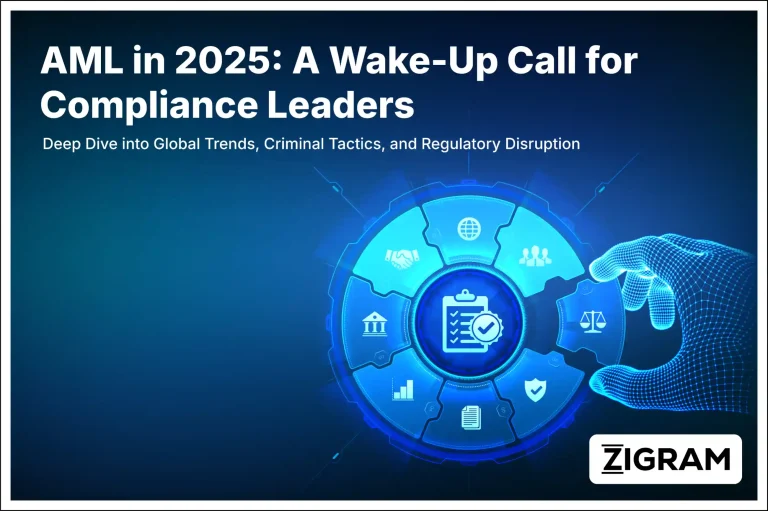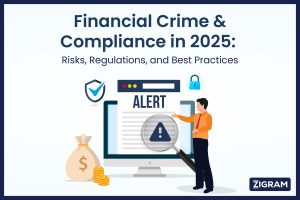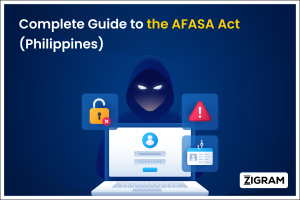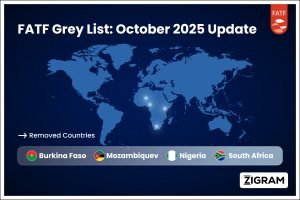Table of Contents
As of mid‑2025, the global anti-money laundering (AML) landscape is at a pivotal crossroads. With illicit financial flows estimated to reach 2–5 % of world GDP, or up to USD 2 trillion annually, and recovery rates languishing at only around 0.1 %, the stakes have never been higher. Despite the complexity and scale of money laundering, 90 % of these illicit transactions still evade detection—underscoring the significant gaps that compliance professionals are racing to close (Shufti Pro).

Key drivers shaping the AML environment include:
- Rapidly evolving geopolitical tensions, from ongoing conflicts in Ukraine and the Middle East to shifting dynamics in the Asia-Pacific—that demand real‑time sanctions screening and enhanced risk frameworks.
- Breakthroughs in artificial intelligence and machine learning, revolutionizing transaction monitoring, identity verification, and risk scoring across sectors.
- Escalating regulatory pressure and transparency mandates, with major reforms such as the U.S. Corporate Transparency Act and the EU’s AMLA and AMLD6 coming into force, significantly tightening beneficial ownership disclosure and compliance across financial and non‑financial domains.
Meanwhile, global regulatory bodies are reinforcing cooperation: FATF continues to expand its mutual evaluation regime, with over 25 jurisdictions currently on its grey list as of June 2025, reflecting growing accountability standards worldwide.
Technology, enforcement, and international coordination are converging to reshape the AML landscape. This article examines the most critical AML trends in 2025, from emerging technology adoption to regulatory shifts, and explores how institutions around the world are adapting to these complex new realities.
If you want a concise article regarding this you can also read:
GENIUS Act Of 2025: Regulatory Framework For Payment Stablecoin
AI, Generative Tools & RPA Are Redefining AML Compliance in 2025
AI Adoption Surges: From Pilot Projects to Enterprise-Wide Systems
- Adoption of AI/ML-powered AML systems continues to expand rapidly: surveys show nearly 90 % of financial institutions using AI by 2025, up from 62% in 2023.
- These systems enhance detection of layered and structured money‑laundering schemes, yielding false positive reductions of up to 40 % and improving overall effectiveness.
This effectively closes a longstanding AML loophole: many crypto issuers had functioned outside of formal oversight.
Real-Time & Predictive Transaction Monitoring Powered by AI
- Real‑time transaction monitoring powered by AI is becoming standard; suspicious patterns are flagged and escalated immediately as transactions occur.
- Predictive behavior analysis enables institutions to anticipate suspicious behavior before broader patterns emerge.
Generative AI in AML: Compliance Ally or Criminal Weapon?
- Institutions are leveraging generative AI to synthesize unstructured data (e.g. adverse media, public records, social media, investigation reports) into cohesive investigative narratives.
- Conversely, criminal actors are using generative AI to automate shell‑company creation, deepfake identity fraud, and synthetic identities at scale—escalating the challenge for AML teams.
RPA and NLP Are Automating AML Workflows and Multilingual Risk Detection
- RPA tools are automating repetitive compliance workflows—such as SAR filing, rule‑based screening, and data extraction—freeing compliance staff for higher‑value tasks.
- NLP continues to enhance adverse media screening, especially in multilingual contexts (e.g. monitoring Bangla and English news streams), achieving accuracy rates around 94% in some pilots. .
Foreign & State‑level Enforcement
- Foreign issuers wanting to offer stablecoins in the U.S. must satisfy U.S. AML standards, register with regulators, hold U.S.-custodied reserves, comply with lawful orders—and will be subject to sanctions designations and potential secondary market bans upon non-compliance.
- State‑regulated issuers under $10 billion can operate under state regimes—but only if those frameworks are deemed “substantially similar” to federal standards; Treasury annually certifies this equivalence. This ensures consistent AML coverage even outside federal oversight.
Global AML Regulation Expands: Beneficial Ownership, New Authorities & Sector Coverage
New Regulatory Authorities Like the EU’s AMLA Are Raising the Bar
- The EU Anti-Money Laundering Authority (AMLA) became fully operational in early 2025 and now oversees uniform enforcement across EU member states, with authority to levy fines and supervise high-risk entities, including crypto platforms and even sports clubs.
- In the U.S., implementation of the Corporate Transparency Act (CTA) from January 1, 2024, mandates private entities to report beneficial ownership, significantly reinforcing transparency standards.
Beneficial Ownership Disclosure Becomes a Global Regulatory Priority
- Regulators globally—including FATF —are pushing for public or centralized beneficial ownership registries, stricter verification routines, and ongoing updates to ownership information.
- Institutions are investing in automated processes to maintain updated UBO (ultimate beneficial owner) data and cross-check external registries for accuracy and new changes.
AML Oversight Broadens to High-Risk Non-Financial Sectors Worldwide
- AML regulation is now applying to non‑financial sectors: real estate, luxury and art markets, gaming platforms, sports clubs, law firms, accountants, and professional services are increasingly recognized as being at risk and are being brought under AML oversight.
Regulators may remove individuals from leadership positions if found grossly negligent in compliance.
Cryptocurrency and Digital Asset Compliance Enters a New Era in 2025
Travel Rule Enforcement and Global Crypto Reporting Take Center Stage
- Countries are intensifying enforcement of the “Travel Rule”, requiring CASPs (Crypto‐Asset Service Providers) to share customer information during crypto transactions—extending traditional banking AML norms into the digital asset realm.
- The OECD’s Crypto-Asset Reporting Framework (CARF) mandates annual reporting and automatic exchange of user data for cross-border crypto transfers, elevating regulatory scrutiny on digital channels.
Blockchain Monitoring Tools Enhance On-Chain AML Visibility
- Institutions are deploying blockchain analytics and smart-contract monitoring to trace illicit flows on-chain, detect layering schemes, and integrate transparency engineering into AML monitoring.
Stablecoins, Privacy Tokens, and Cross-Border Crypto Risk Management
- Emerging focus areas include stablecoins and privacy-focused tokens. Criminal actors are using cross‑chain bridges and opaque asset types to mask illicit finance—banks are responding by deploying real‑time sanctions screening tools and flagging cross‑border crypto flows.
Cross-Border AML Collaboration & Standardization in 2025
Public-Private Partnerships Driving Faster AML Intelligence Sharing
- AML effectiveness is rising via public-private collaboration: regulators, banks, fintech, law enforcement, and FIUs now regularly share intelligence—leading to faster case resolution and broader threat detection. Some jurisdictions report up to 4x faster investigative outcomes thanks to formal PPPs.
Egmont Group & FIUs Strengthen Cross-Border AML Networks
- FIUs coordinated through the Egmont Group continue strengthening cross-border intelligence sharing via secure platforms like the Egmont Secure Web—supporting global detection of suspicious patterns across countries.
Global Alignment of AML Standards Through FATF and AMLA
- Regional harmonization efforts, led by entities such as the EU and FATF, are progressively aligning AML standards across jurisdictions. The rollout of the EU’s AMLA framework is a prime example of coordinated compliance structures across member states.
Integrating ESG and Predicate Crime Typologies into AML Compliance Frameworks
ESG Risks Become a Core Component of AML Risk Assessment
- AML frameworks now integrate ESG risks—tracking illicit financing related to environmental crimes (illegal logging, wildlife trafficking, unregulated mining), human rights violations, and forced labor—all considered predicate crimes with potential money laundering proceeds.
Predicate Crime Typologies Expand to Include Corruption, Fraud, and Trafficking
- AML systems now build in detection modules targeting broader predicate crime typologies—particularly corruption, bribery, human trafficking, fraud, and environmental offenses, often prioritized by regulators and enforcement bodies.
Rising Compliance Accountability and Regulatory Enforcement in AML Oversight
Personal Liability Increases for Compliance Officers and Senior Executives
- Regulators are increasingly imposing personal accountability on compliance officers and senior executives for AML compliance failures. Professional responsibility and even legal liability are on the rise—making oversight roles more exposed.
Sanctions Enforcement and Risk-Based Screening Intensify Globally
- Enforcement actions continue aggressively: regulators frequently update sanctions lists in response to geopolitical events. Companies must adopt real‑time screening to avoid prohibited transactions and maintain risk-based sanctions frameworks.
- For example, the EU recently removed the UAE from its high‑risk AML list on June 10, 2025, signaling recognition of improved controls—but such delistings remain rare and carefully monitored.
Evolving Criminal Tactics: Synthetic Fraud, AI Abuse, and Trade-Based Laundering
Criminal Networks Leverage Generative AI for Scalable Fraud Operations
- Criminals are increasingly using generative AI to automate illicit processes: building shell companies, generating forged documents, manipulating identities, and designing advanced smurfing schemes at scale.
Synthetic Identities and Deepfakes Drive Massive Compliance Risks
- Synthetic identity fraud is accelerating: institutions lost more than US $6 billion in 2024 to fake but convincing identity profiles generated using AI tools. Regulators and banks are responding by strengthening CDD and adopting digital identity verification systems.
Trade-Based Money Laundering and High-Value Asset Abuse Remain Persistent Threats
- Trade-based money laundering (TBML) continues to be a major channel: illicit financial flows concealed through over-/under-invoicing, misclassification, and shell company trade schemes.
- Similarly, high-risk sectors such as real estate, luxury goods, art markets, and gaming platforms have drawn tighter scrutiny due to their liquidity and opacity.
The Rise of RegTech: Compliance Automation, Cloud Platforms, and Privacy Innovation
RegTech Market Growth Accelerates as Compliance Demand Surges
- The global RegTech and AML-tech market is growing sharply: estimated at USD 3.1 billion in 2023, projected to reach USD 6.8 billion by 2028 (CAGR 17%) and surpass USD 9 billion by 2030 (marketsandmarkets.com) .
- RegTech tools—covering automated KYC, onboarding, sanctions screening, transaction monitoring, and reporting—are now core to enterprise compliance infrastructures.
Cloud-Native and Integrated AML Platforms Become the New Standard
- Cloud-based AML platforms are increasingly preferred for scalability, real‑time updates, and seamless integration with CRM, payment, and identity systems.
- Integrated suites combining KYC, transaction monitoring, fraud, and sanctions screening are gaining traction, offering holistic compliance management.
Privacy-Preserving Analytics Power Secure and Collaborative Compliance
- Emerging research focuses on privacy-preserving graph-based ML, including Federated Learning and Fully Homomorphic Encryption, enabling secure cross-institutional collaboration without exposing sensitive financial data. Some models maintain over 99 % accuracy on encrypted datasets.
Strengthening AML with Digital Identity Verification and Enhanced Due Diligence
Biometric Verification and Digital Identity Wallets Improve KYC Accuracy
- Biometric authentication (facial recognition, fingerprint scanning) and digital identity wallets are increasingly implemented in onboarding and ongoing monitoring workflows, reducing KYC drop-off rates and improving verification accuracy.
Continuous Monitoring Replaces Static KYC Across AML Workflows
- KYC is shifting from a one-time event to continuous due diligence: periodic updates and ongoing monitoring for changes in ownership, risk profile, or adverse media exposure are now industry standard globally.
EDD Frameworks Deepen Risk Analysis for High-Risk and Complex Clients
- For PEPs, high-net-worth individuals, and complex corporate structures, institutions are implementing EDD frameworks that require deeper investigations, relationship mapping, and source-of-funds validation.
Adopting Risk-Based and ESG-Aligned Strategies in Modern AML Frameworks
Risk-Based AML Frameworks Align Compliance with Real-World Threat Levels
- Regulatory guidance increasingly mandates risk-based approaches: institutions must align compliance resources proportionately to customer risk, product complexity, jurisdictional threats, and typology trends.
ESG Indicators Now Integrated into AML Risk Scoring Models
- AML risk frameworks now embed ESG indicators, enabling organizations to identify clients linked to environmental crimes, human rights violations, or governance failures. This intersectional risk scoring enhances compliance credibility and aligns with broader regulatory expectations.
Regional AML Developments in 2025: Asia-Pacific, India, US & EU
India & Asia-Pacific Lead AML Tech Adoption and Cross-Border Cooperation
- The Asia‑Pacific region, led by India, China, and Singapore, is witnessing one of the fastest surges in AML technology adoption driven by economic growth, digital transaction volume, and regulatory tightening.
- India has shown increasing willingness to share AML intelligence via FIUs and public-private channels, aligning with global best practices.
- Emerging use of AI/NLP technology in multilingual compliance (e.g. Bangla adverse media detection) demonstrates advanced regional initiatives.
Evolving AML Regulations in the U.S. and EU Signal High-Stakes Enforcement
- In the United States, despite advocacy by banks for deregulation, AML enforcement remains bipartisan and firm. Proposals to raise the cash transaction reporting threshold (currently $10,000) to $75K–$100K are under discussion, but critics argue this could weaken the detection of illicit flows (reuters.com).
- The EU’s removal of UAE and several other countries from its high‑risk AML list on June 10, 2025 reflects international acknowledgment of regulatory improvements—but it also signals continued vigilance and high standards for delisting (timesofindia.indiatimes.com) .
Strategic Priorities and AML Risks for Key Stakeholders in 2025 and Beyond
Financial Institutions
- Must invest in AI/ML-driven transaction monitoring, blockchain analytics, and integrative compliance platforms.
- Must fortify KYC/CDD pipelines with biometric identity, continuous monitoring, and beneficial ownership registry integration.
Regulators & Governments
- Should continue supporting shared data frameworks, expanding AML regulation across non‑bank sectors, enforcing personal liability for compliance failures, and fostering global harmonization (e.g. through AMLA, FATF, CARF).
Non-Financial Entities (Real Estate, Art, Gaming, Legal/Accounting)
- Should proactively develop internal AML controls and onboarding procedures to meet rising regulatory expectations across sectors.
RegTech & Compliance Vendors
- Need to innovate privacy-preserving AI, RPA tools, connected KYC/transaction monitoring suites, and cross-chain analytics aligned to evolving global frameworks like CARF and EDD mandates.
The Road Ahead for AML: Evolving Threats, Technology Imperatives, and Global Alignment
- Expect greater regulatory pressure on crypto-asset service providers—with ongoing Travel Rule enforcement, sanctions screening, and AML/CFT licensing.
- Generative AI misuse remains a top threat: synthetic identity, AI‑driven layering, and shell company creation could undermine traditional compliance defences.
- Closer ESG‑AML alignment will be demanded by regulators and investors alike—driving demand for deeper risk-scoring and predicate crime linkage.
- Institutions that heavily rely on legacy manual compliance tools will face escalating operational risk, increased fines, and reputational damage as regulators continue enforcement.
Conclusion
In 2025, the AML landscape is characterized by:
- The central role of AI and automation (transaction monitoring, RPA, NLP, generative prompts).
- Expanded scope of regulatory coverage, across sectors and ownership transparency.
- Increasing integration of cryptocurrency compliance frameworks, including Travel Rule enforcement and global reporting.
- A shift towards data sharing, cross-sector collaboration, and harmonized global standards (e.g. AMLA, FATF, Egmont cooperation).
- A nuanced inclusion of ESG and predicate crime indicators into compliance strategies.
- Rising stakeholder accountability and executive liability, along with dynamic sanctions enforcement.
Key Trend Summary Table
Trend Area | Key Insight |
AI & ML | Widespread adoption, real-time monitoring, predictive detection |
Generative AI | Enables both compliance narrative building and criminal automation |
Beneficial Ownership | Mandatory registries, enhanced UBO verification, global registry drives |
Crypto Regulation | Travel Rule compliance, CARF reporting, chain analytics |
RPA / RegTech | Automation of SAR, KYC, screening workflows |
ESG & Predicate Crimes | AML frameworks incorporate environmental, social, and governance risks |
Identity & EDD | Biometric onboarding, continuous monitoring, enhanced due diligence |
Accountability | Personal liability for compliance officers, dynamic sanctions environment |
Market Growth | RegTech market rapidly growing; cloud-based and privacy-preserving systems |
Sources
News & Analysis
Reuters – “Keeping crypto clean: risk-based controls for stablecoins,” detailing AML integration into the GENIUS Act framework (Reuters)
Reuters – “Stablecoins set up another Trump‑Fed showdown,” on freeze/block capabilities and regulatory landscape (Reuters)
Reuters – “US House sends ‘Genius Act’ stablecoin bill to Trump to sign,” on House passage (Reuters)
Legal & Industry Briefs
Gibson Dunn – “The GENIUS Act: A New Era of Stablecoin Regulation,” covering enforcement tools, BSA/sanctions, certifications (Gibson Dunn)
Pillsbury – “The GENIUS Act: A New Federal Framework for Stablecoin Issuers,” covering BSA compliance requirements and certifications (Pillsbury Law)
Arnold Porter – “What You Need to Know About the New Stablecoin Legislation,” detailing issuer categories, reserve standards, and reserve disclosure (Arnold & Porter)
WilmerHale – “What the GENIUS Act Means for Payment Stablecoin Issuers,” outlining reserve backing and consumer protection goals (WilmerHale)
Skadden – “US Establishes First Federal Regulatory Framework for Stablecoins,” on FinCEN guidance timings and insolvency protections (Skadden)
Chainalysis – “What the GENIUS Act & Market Structure Bills Mean for Crypto Compliance,” emphasizing AML innovation & FinCEN obligations (chainalysis.com)
Reuters – coverage of “Circle’s IPO and the new era of stablecoin regulation” (Reuters)
Reference Legislation & Regulatory Background
Wikipedia (GENIUS Act) – baseline information on enactment dates, definitions, and scope (Wikipedia)
Wikipedia (Bank Secrecy Act) – background on BSA and AML framework (Wikipedia)
Wikipedia (FinCEN) – context on the AML authority deploying guidance under the BSA (Pillsbury Law)
- #GENIUSAct
- #Stablecoins
- #AML
- #FinancialCrime
- #Compliance
- #CryptoRegulation
- #FinCEN
- #SanctionsCompliance
- #RegTech
- #AntiMoneyLaundering
- #DigitalAssets
- #FinancialSecurity







